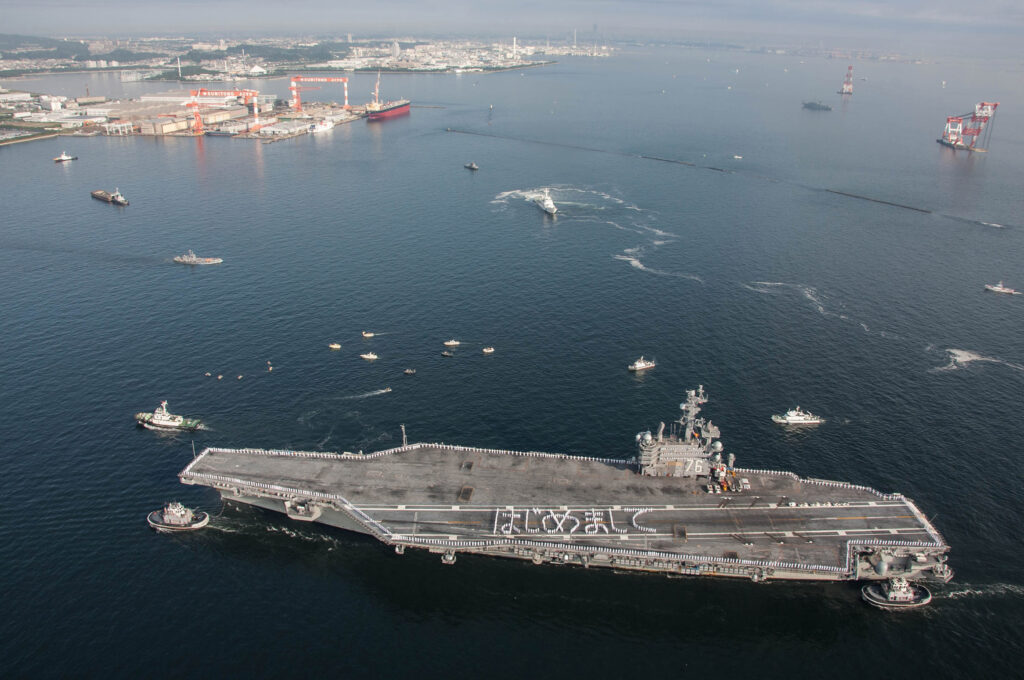More Ships Can’t Save Overworked Navy; Basing Ships Abroad Can: CSBA
Posted on

The carrier USS Ronald Reagan arrives at its new base in Yokosuka, Japan, replacing the USS George Washington.
CAPITOL HILL: The Navy and Marines are deploying at a pace they can’t sustain, says a report released today.And no feasible defense budget can build a big enough force to solve the problem, the Center for Strategic and Budgetary Assessments says. Even the Navy’s famously optimistic 30-year shipbuilding plan — denounced by House seapower chairman Randy Forbes as “fantasyland” — wouldn’t close the gap between the supply of ships and the demand for them.
So more shipbuilding isn’t the solution. That is probably not the conclusion the Navy League was hoping for when it commissioned the study: “They didn’t really know what they were going to get,” said lead author Bryan Clark when he thanked his sponsors this morning. But if we can’t build our way out, what can we do?
We have to get more deployment time out of whatever ships we’ve got, said Clark, a former top aide to the Chief of Naval Operations. That includes expedients Congress may not like, especially basing more ships overseas.

Bryan Clark
Today, the Navy’s doing more with less by cutting into crew rest, training, and maintenance, but that’s not sustainable. In fact, the consequences have been coming back to bite us already. Unplanned repairs on the carrier Nimitz forced the USS Eisenhower to cover its missions by doing two deployments back-to-back. Then the Eisenhower in turn needed months of extra maintenance. All told, to keep the number of ships on station the same as the number of ships in the Navy shrinks, the workload per ship has risen 20 percent since 1998.
Clark advocates getting more days on station by eliminating long voyages from base to theater. “The transit time to and from the Middle East or the Western Pacific takes about 15 to 20 percent of your deployment,” he told reporters. To cut out that transit time — and to get effectively 15 to 20 percent more out of each ship — we need to move ships out of homeports in the US and base them abroad, mainly in the Pacific: Guam, perhaps Australia, and above all Japan.
This is not an option that will endear Clark to Congress. Every ship and crew based overseas means less money being spent in their districts and fewer jobs for their constituents. But Clark argued legislators can be brought round. In 2012, he recalled, he helped then-Chief of Naval Operations Adm. Jonathan Greenert brief members of Congress on the Navy’s rebasing plans at the time. Those included moving four destroyers to Spain and shuffling ships from the East Coast to the West as part of the “Pacific Pivot.”
“The members didn’t like it, [but] the members understood it,” Clark said. They understood that “everybody’s losing” — that is, no one district was being singled out unfairly — and that “there’s a strategic basis to this that makes sense, [so] they were very accepting of this idea.”
So, with ambivalent approval from Congress, the Navy has already begun re-basing some ships abroad. The largest single movement is those four Aegis destroyers to Rota, Spain, from which they’ll provide on-tap missile defense for Europe. A submarine is going to Guam. The service is also sending its controversial Littoral Combat Ships for extended tours in Singapore, although for political reasons that country can’t be a permanent base. LCS will probably also go to Bahrain as more are built.
Still, the crown jewel of the foreign-based fleet is in Japan. There’s already an aircraft carrier, amphibious ships, escorts, aircraft, and crews stationed semi-permanently in Yokosuka and Sasebo. (“Semi” because they come back to the US when due for major overhauls). These ports can accommodate more ships, Clark said. There’d be some shuffling and a few million dollars in upgrades to handle a second carrier, he said, but that’s far cheaper and quicker than building a new vessel.
If you allow for training, rest, and maintenance — all of which the Navy’s been cutting corners on — as well as transit time across the oceans, then one ship based in the United States spends up to 25 percent of its time forward-deployed. A Japan-based ship is operating forward 67 percent of the time. (The other third it’s in maintenance).
In other words, a bird based in Japan is worth three in the US. The higher tempo of operations also costs more — about 30 percent — but you’re still getting a lot more days deployed for your dollar.
Moving one more carrier to Japan would have cascading benefits around the world, Clark calculates.
- Basing a second flat-top in Yokosuka would allow the Japan-based fleet to meet the entire demand for carrier coverage in the Pacific.
- That, in turn, would free up the West Coast-based carriers from Pacific duties and allow them to focus on the Middle East, eliminating “carrier gaps” in the Persian Gulf.
- Focusing the West Coast carriers on the Middle East would also free up the East Coast-based carriers to cover the much-neglected European and Mediterranean theaters. Those areas arguably need more coverage all the time, given the resurgence of Russia and the spread of the self-proclaimed Islamic State.
(Basing a carrier in Europe itself doesn’t get you much, Clark said, because the transit time from the East Coast is only about a week. It’s getting rid of those long transits across the Pacific that really allow the whole fleet to be much more efficient).
 How attractive is this concept to Congress? The legislators who spoke at the report’s roll-out today kept their remarks general, but I followed seapower chairman Forbes down the hallway to press him on the specifics of the Navy’s problem.
How attractive is this concept to Congress? The legislators who spoke at the report’s roll-out today kept their remarks general, but I followed seapower chairman Forbes down the hallway to press him on the specifics of the Navy’s problem.
“It can’t be solved by simply building more ships. That doesn’t mean that building more ships is not part of a [solution],” Forbes told me. “So while it is true that I can’t simply build my way out — I can’t even spend my way out, Sydney — that doesn’t mean that I don’t need to spend more and I don’t need to build more.”
Can you persuade fellow legislators to give up their home state ships and let the Navy move vessels abroad? “It’s not easy,” Forbes said, “but… I don’t know that you have to go there.”
“I think what you have to do is make sure we’ve got adequate platforms,” Forbes said, i.e. enough ships and other power-projection forces like the Long-Range Strike Bomber, all wielded together in a “holistic” strategy.
“What you see Bryan doing is throwing one possibility out there,” Forbes said. “You may not agree with every answer [in the report], but it’s the question that’s important.”
A Senate Armed Services Committee staffer seemed somewhat more receptive: “We need seapower that is forward, present, and ready. While we need to grow the size of the Navy, it is imperative that we consider innovative ways to generate more affordable forward presence, such as those presented in this report.”
That’s still not a ringing endorsement of basing more ships abroad. But with the shipbuilding budget under pressure, ships in high demand, and the current corner-cutting unsustainable, the Navy needs to do something different — or just do less. Congress has to decide which outcome it hates more.
Updated 3;25 pm with SASC comment
Subscribe to our newsletter
Promotions, new products and sales. Directly to your inbox.
